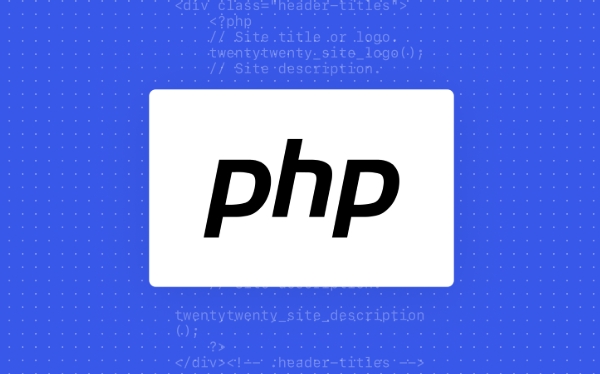Leveraging PHPDoc Blocks for Superior Code Maintainability
Jul 24, 2025 pm 10:25 PMPHPDoc significantly enhances PHP code maintainability and clarity. 1. It provides type clarity even without strict typing, documenting parameters, return values, and properties with precision. 2. It describes complex return types like structured arrays, nullable values, and union types, making expectations explicit. 3. It improves IDE support and helps catch bugs early by enabling accurate autocompletion, error detection, and null safety checks. 4. It documents class properties in DTOs or models where native typing isn’t used, ensuring consistent type understanding. 5. It accelerates onboarding by serving as inline documentation, reducing ambiguity and encouraging developers to clarify their intent. Common useful tags include @param, @return, @var, @throws, @deprecated, and @internal, while redundant ones should be avoided. Used effectively, PHPDoc acts as essential scaffolding that bridges PHP’s type system limitations, boosts static analysis, and future-proofs codebases.

Leveraging PHPDoc blocks isn’t just about making your IDE autocomplete better — it’s a practical step toward writing more maintainable, self-documenting PHP code. When used consistently, PHPDoc annotations clarify intent, improve collaboration, and reduce the cognitive load for developers reading or modifying code later.

Here’s how thoughtful use of PHPDoc enhances long-term code health:
1. Type Clarity Without Strict Typing Everywhere
Even if your PHP version or project doesn’t enforce strict typing, PHPDoc gives you a way to document expected types for parameters, return values, and properties.

/**
* Fetches user data by ID.
*
* @param int $userId The unique identifier of the user
* @return array{first_name: string, last_name: string, email: string}|null User data or null if not found
*/
function getUserById(int $userId): ?array
{
// ...
}This is especially useful when working with arrays that have a specific structure, nullable returns, or union types — things that PHP’s native type system didn’t fully support before PHP 8.x. Your IDE (and static analyzers like PHPStan or Psalm) can now validate usage based on this.
2. Documenting Complex Return Types
PHP’s native scalar types don’t capture everything. Use PHPDoc to describe:

- Arrays with structured content
- Nullable or multiple return types
- Objects with known shapes
For example:
/**
* @return array<int, array{title: string, published: bool}>
*/
function getArticles(): array
{
// Returns a list of article records
}Without this, someone reading the code would have to dig into the function body or guess based on context. With it, they instantly know what to expect.
3. Improving IDE Support and Catching Bugs Early
Modern tools like PhpStorm, PHPStan, and Psalm rely heavily on PHPDoc to:
- Suggest correct method calls
- Flag incorrect variable usage
- Detect potential
nullaccess errors
For instance:
/** @var \DateTimeImmutable|null $createdAt */
$createdAt = $this->getCreationDate();
if ($createdAt) {
echo $createdAt->format('Y-m-d'); // IDE knows it's safe to call format()
}Even if $createdAt comes from a loosely-typed source, the annotation tells the toolchain what it should be — reducing runtime surprises.
4. Describing Class Properties (Especially in DTOs or Models)
In classes that hold data (like DTOs or ORM entities), properties often lack PHP 7.4 typed properties for flexibility or legacy reasons. PHPDoc fills the gap:
class User
{
/** @var int */
private $id;
/** @var string */
private $email;
/** @var array<string, mixed> */
private $metadata;
}Now, any method interacting with these properties benefits from type insight — even without PHP’s native type declarations.
5. Onboarding New Developers Faster
Clear PHPDoc acts as inline documentation. When new team members read your code, they don’t need to ask, “What does this function return?” or “What should I pass here?” The comments answer those questions directly.
It also encourages better thinking during development: writing a precise @param or @return forces you to clarify your own assumptions.
Bonus: Common PHPDoc Tags Worth Using
-
@param <type> [$var] [description]</type>– Describe function parameters -
@return <type> [description]</type>– Clarify return values -
@var <type> [description]</type>– Annotate properties or variables -
@throws <exceptionclass> [description]</exceptionclass>– Document expected exceptions -
@deprecated– Mark outdated code -
@internal– Indicate code not meant for public use
Avoid redundant tags (like @return void on a function with no return), but don’t skip ones that add real value.
Used wisely, PHPDoc isn’t clutter — it’s scaffolding for sustainable code. It bridges gaps in PHP’s type system, boosts tooling intelligence, and makes your codebase easier to navigate and evolve.
Basically: if you’re not using PHPDoc beyond basic comments, you’re missing a low-effort, high-impact way to future-proof your PHP projects.
The above is the detailed content of Leveraging PHPDoc Blocks for Superior Code Maintainability. For more information, please follow other related articles on the PHP Chinese website!

Hot AI Tools

Undress AI Tool
Undress images for free

Undresser.AI Undress
AI-powered app for creating realistic nude photos

AI Clothes Remover
Online AI tool for removing clothes from photos.

Clothoff.io
AI clothes remover

Video Face Swap
Swap faces in any video effortlessly with our completely free AI face swap tool!

Hot Article

Hot Tools

Notepad++7.3.1
Easy-to-use and free code editor

SublimeText3 Chinese version
Chinese version, very easy to use

Zend Studio 13.0.1
Powerful PHP integrated development environment

Dreamweaver CS6
Visual web development tools

SublimeText3 Mac version
God-level code editing software (SublimeText3)

Hot Topics
 Multiline vs. Single-Line Comments: A Strategic Guide for PHP Developers
Jul 27, 2025 am 04:33 AM
Multiline vs. Single-Line Comments: A Strategic Guide for PHP Developers
Jul 27, 2025 am 04:33 AM
Single-line comments (//) are suitable for short, local instructions or debugging, 1. Use // for in-line comments or temporarily disable code; 2. Use // for multi-line comments to provide detailed descriptions of complex logic or comment large pieces of code; 3. Use /*/ to write PHPDoc to implement structured documents and integrate with the IDE; 4. Avoid comments to be obvious code; 5. Always keep comments updated to ensure comments clearly convey intentions rather than just describe operations, thereby improving code maintainability.
 The Perils of Nested Multiline Comments in PHP
Jul 26, 2025 am 09:53 AM
The Perils of Nested Multiline Comments in PHP
Jul 26, 2025 am 09:53 AM
PHPdoesnotsupportnestedmultilinecomments,andattemptingtonestthemcancauseunexpectedcodeexecutionorparseerrors;thefirst/closestheentirecommentblock,soanycodefollowingit—evenifintendedtobecommented—willbeexecuted,leadingtobugsorfatalerrorswhenfunctionsa
 Writing Clean File Headers: A Standardized Approach with Multiline Comments
Jul 25, 2025 am 11:13 AM
Writing Clean File Headers: A Standardized Approach with Multiline Comments
Jul 25, 2025 am 11:13 AM
Awell-structuredfileheaderimprovescodereadabilityandcollaborationbyprovidingkeyfileinformationupfront.1.Includethefile’spurpose,author,creationandmodificationdates,version,license,dependencies,andoptionalnotes.2.Useaconsistentmultilinecommentformatli
 How Modern IDEs Transform PHP Comments into Navigational Tools
Jul 25, 2025 am 04:43 AM
How Modern IDEs Transform PHP Comments into Navigational Tools
Jul 25, 2025 am 04:43 AM
PHPDoccommentsprovidetypehints,enableautocomplete,detecterrors,andsupportnavigationinIDEsbyactingasstructuredmetadata.2.Specialinlinecommentslike//TODOor//FIXMEareparsedintoactionabletasks,allowingdeveloperstonavigate,filter,andtrackworkdirectlyfromt
 Leveraging PHPDoc Blocks for Superior Code Maintainability
Jul 24, 2025 pm 10:25 PM
Leveraging PHPDoc Blocks for Superior Code Maintainability
Jul 24, 2025 pm 10:25 PM
PHPDocsignificantlyenhancesPHPcodemaintainabilityandclarity.1.Itprovidestypeclarityevenwithoutstricttyping,documentingparameters,returnvalues,andpropertieswithprecision.2.Itdescribescomplexreturntypeslikestructuredarrays,nullablevalues,anduniontypes,
 Mastering the Nuances of PHP Block Commenting
Jul 26, 2025 am 09:42 AM
Mastering the Nuances of PHP Block Commenting
Jul 26, 2025 am 09:42 AM
PHPblockcommentingisessentialfordocumentinglogic,disablingcode,andcreatingstructureddocblocks;1.Use//formulti-linecommentsbutavoidnesting,asitcausesparseerrors;2.Youcansafelyinclude//commentsinside//blocks;3.Alwayscloseblockcommentswith/topreventunin
 From Comments to Contracts: The Power of PHPDoc Annotations
Jul 25, 2025 am 04:41 AM
From Comments to Contracts: The Power of PHPDoc Annotations
Jul 25, 2025 am 04:41 AM
PHPDoccommentsarenotjustfordocumentation—theyserveasstructuredmetadatathatenhancecodereliabilityandmaintainability.1)TheyprovidetypehintsbeyondPHP’snativesyntax,allowingprecisedefinitionslikearrayornullabletypes,whichtoolslikePHPStanuseforstaticanaly
 The Unsung Hero: Enhancing Code Clarity with PHP Multiline Blocks
Jul 25, 2025 pm 02:29 PM
The Unsung Hero: Enhancing Code Clarity with PHP Multiline Blocks
Jul 25, 2025 pm 02:29 PM
PHP's Heredoc and Nowdoc are effective tools to improve code readability and maintainability. 1. Heredoc supports variable interpolation, suitable for dynamic content such as HTML or JSON; 2. Nowdoc does not parse variables, suitable for plain text output; 3. Both avoid the confusion of quotation escapes and string splicing, making multi-line strings clearer; 4. When using it, make sure that the end identifier occupies one line and has no front and back spaces; 5. Direct insertion of untrusted data should be avoided to prevent security risks; 6. Code readability can be enhanced through unified naming separators (such as HTML, SQL). Reasonable use can significantly reduce cognitive load and improve development efficiency.






